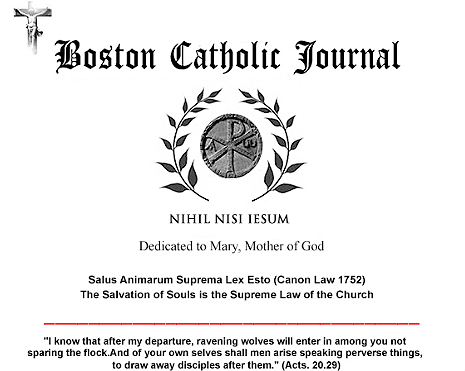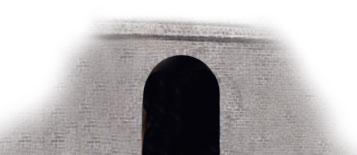|

The
Faith of Fools

... and the Painted Tunnel
Faith
is much like a painted tunnel
set upon the face
of a granite wall, and we are invited to run into it — full
speed — not knowing whether the dark opening is an illusion, or
if a tunnel, how deep it is, and whether it bends immediately to the
right or turns sharply to the left. We do not know if it falls precipitously
down or steeply curves up ... if it is not an illusion at all. We have
no idea how wide it is.
Some have told us that it is a real tunnel. Others have told us that
it is just black paint artfully brushed on a solid wall. We only really
see the wall around it. This we believe to be real. We have approached
the wall and knocked our knuckles against the granite face on all the
sides surrounding what appears to be a black opening, and after a few
vigorous attempts we find our knuckles sore and because the surface
is uneven, bleeding.
Someone comes along and asks us to instantly run at the black opening.
We are told that depending on the speed at which we run, we will enter
the more deeply into the tunnel ... which for all appearances and in
all probability is just a painted surface. We can walk carefully toward
it and very, very slowly approach what appears to be a dark opening.
This way, if it is an illusion, the injury to ourselves will be minimal.
If we rush at it full speed and the apparent opening is just that an
“apparent” we will be seriously injured, and what is more, look like
fools in the effort. After all, we had been warned by others, in fact,
by many others, that it is an illusion created by a clever artist, much
like the three dimensional drawings we have seen on the sidewalks of
large cities, skillfully drawn by enterprising artists. There “appears”
to be depth, and we are amazed at the skill, and may even, for all our
realization that it is a carefully crafted illusion, blench before stepping
over the outer periphery of the drawing.
This is a most apposite metaphor for Faith, and Christ is either a clever
artist or we are simply credulous fools. It may be both. Perhaps the
skill of the Artist depends heavily on the gullibility of the fool.
Moreover, most of the fools are not the literati, the well-educated,
the scholars, those who know the real state of affairs in the world,
and hold multiples degrees to attest to this. They clearly are not willing
to be fools.
So what of the rest of us? What of those who, like us, stand in perplexity,
hesitation, and even doubt before the “painted”¯ tunnel? All of them,
all of us, have inadvertently walked into brick walls and know the penalty
of our inattentiveness ā€¦ and we walk away, ashamed that we have shown
ourselves fools.
Let us further suppose that it is widely rumored that many have actually
run into the painted tunnel — and are never heard from again! What are
we to make of this? What has become of them? Is it good or bad? We have
no way of knowing — even if such rumors have some apparent
substance to them.
What is more, we have known some people who have in fact run into the
wall and immediately recoiled off it, suffering greatly, and coming
away “the wiser”, knowing from experience that the tunnel is an illusion,
and who can even show you the scars of that regrettable encounter.
An Illusion?
Even if the “painted”¯
tunnel is not an illusion as some maintain, although they themselves
only believe it without actually having run into it head on and at full
speed — it appears to be of an unpredictable nature. Sometimes it proves
to be an opening, and sometimes not. In fact, some have claimed to enter
it — and to have returned! While we cannot verify that they have in
fact entered it, it certainly appears to be the case that, in a different
way, their lives, too, have been changed as a result — much like those
who bounced off the wall.
Why would this
“opening” be of such a nature that for some it proves to be, in fact,
a real opening, while for others it turns out to be an illusion? Why
do they return from their encounter with the painted tunnel with such
strikingly different — even totally conflicting — accounts?
We — who are merely
spectators of this drama — really have no idea, still less assurance,
of the likelihood of our own experience with the painted tunnel, which
all of us at least see, and will never know, cannot know, until we ourselves
participate in the drama. We behold alike the wounded and the healed
as a result of their encounter with the “tunnel”. We stand on the sidelines,
observing this bizarre spectacle, hoping to attain to some certainty,
one way or another, through the experience of others. Again and again
we fluctuate between believing that the tunnel is real and that it is
painted. We watch one limp away, and we disbelieve. The next moment
we watch another return, made whole, and we believe. The one thing we
do not doubt is that the painted tunnel will change us, one way or another,
and that we can only find out which way if we run into it.
There is another
unique characteristic of the tunnel: as we grow older the opening looms
larger. It is not more real or less real, more apparent or less apparent;
it is just ā€¦ more obtrusive.
This, in turn,
reveals something uniquely characteristic of us: a growing reluctance
to run into the wall. It is not so much that we fear being injured as
a consequence, as we fear discovering that it is only an illusion after
all, a mere painting, very old, but nevertheless very vivid.
Why is this? Because
even our doubt contains within itself at least the latency of belief.
We do not doubt what we do not believe, or what we know is not the case.
We only doubt what, for all its improbability, is yet the possibility
of being real. And this is to say that doubt itself contains an implicit
acknowledgement of the very thing doubted. Even if belief is suspended,
it is not entirely abandoned. It is a comfortable position. While we
forfeit any possible benefit of belief, we incur no penalty that would
result from a validated disbelief. In other words, we are more comfortable
without the consolation of finding that our belief corresponds to a
reality, than we are in possibly finding that our disbelief corresponds
to a reality — that there is nothing, that the tunnel is a painting
on an opaque and impenetrable wall, that it is an illusion only, beyond
which there is nothing. Better to implicitly hope there is something
and find oneself pleasantly surprised that it is indeed the case despite
all improbability — than to relinquish hope altogether in finding that
there is nothing.
The problem with
this approach is Jesus Christ. He does not ask you to take a stand.
He requires you to take a stand. Not on the issue, but on Him. The issue
after all, at least if you are a Catholic, is inseparable from Him.
You cannot stand on the sidelines. One way or another you will be forced
to come to terms with the tunnel. And the way you approach it is very
likely the measure you enter into the life of Christ.
You can pass
it by altogether, fearful of what it will require of you if you enter
the tunnel, or of finding there is nothing if you merely collide with
it, with what was the possibility that there was nothing and
finding out that there really is nothing, and living with that realization.
Hitting the Wall
You can also approach
it tentatively, cautiously, carefully, seeking at every step to verify
something of the reality of the tunnel before moving a step closer until,
sufficiently assured, and with great apprehension, you make the final
“actus fidei”¯, or “act of faith”, and fall forward against
the black opening that may yet still be a solid wall — and breathe a
sigh of relief that your modicum of faith, yet imbued with doubt, did
not fail you.
Or you can run
into the tunnel full speed in the face of all improbability and against
all the palpable evidence that it is just a painted tunnel on an unyielding
surface — and enter the depths of the Heart of Christ Himself.
Ah, yes, you ask
— nevertheless, what of those who ran and recoiled off the wall? We
would be dishonest if we cannot answer this. This, ultimately, is at
the heart of the mystery of Faith itself which, were it possessed of
certainty, would not be faith. God alone knows the depths and the motives
of the human heart. There is no “methodology”¯ to Heaven. Indeed, none
of us are assured of our own salvation which, St. Paul tells us, we
work out with fear and trembling.
One thing is certain:
you will know nothing of it — and very likely suffer greatly because
you wish to know nothing definitive of it — whether it is real or an
illusion — until you throw yourself against the wall.
Editor
Boston Catholic Journal
 Printable
PDF Version
Printable
PDF Version

Totally Faithful to the Sacred
Deposit of Faith entrusted to the Holy See in Rome
“Scio
opera tua ... quia modicum habes virtutem, et servasti verbum
Meum, nec non negasti Nomen Meum”
“I
know your works ... that you have but little power, and
yet you have kept My word, and have not denied My Name.”
(Apocalypse
3.8)
Copyright © 2004 - 2025 Boston Catholic
Journal. All rights reserved. Unless otherwise stated, permission
is granted by the Boston Catholic Journal for the copying
and distribution of the articles and audio files under the
following conditions: No additions, deletions, or
changes are to be made to the text or audio files in any
way, and the copies may not be sold for a profit. In the
reproduction, in any format of any image, graphic, text,
or audio file, attribution must be given to the Boston Catholic
Journal.
|
|